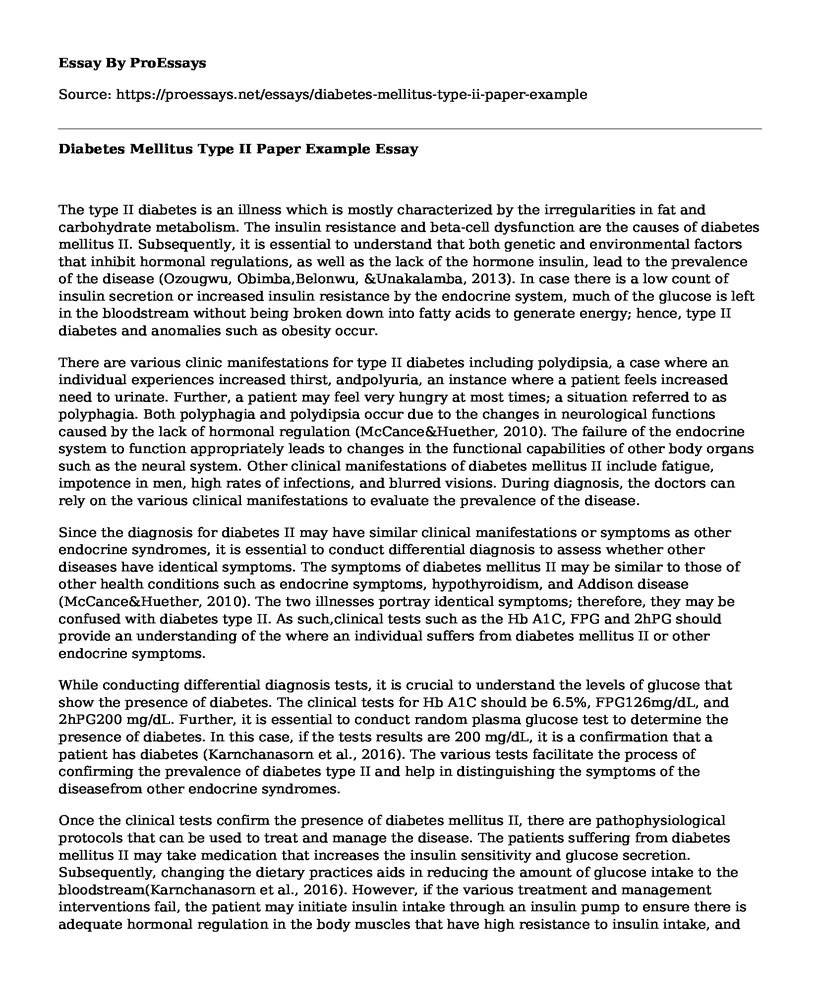The type II diabetes is an illness which is mostly characterized by the irregularities in fat and carbohydrate metabolism. The insulin resistance and beta-cell dysfunction are the causes of diabetes mellitus II. Subsequently, it is essential to understand that both genetic and environmental factors that inhibit hormonal regulations, as well as the lack of the hormone insulin, lead to the prevalence of the disease (Ozougwu, Obimba,Belonwu, &Unakalamba, 2013). In case there is a low count of insulin secretion or increased insulin resistance by the endocrine system, much of the glucose is left in the bloodstream without being broken down into fatty acids to generate energy; hence, type II diabetes and anomalies such as obesity occur.
There are various clinic manifestations for type II diabetes including polydipsia, a case where an individual experiences increased thirst, andpolyuria, an instance where a patient feels increased need to urinate. Further, a patient may feel very hungry at most times; a situation referred to as polyphagia. Both polyphagia and polydipsia occur due to the changes in neurological functions caused by the lack of hormonal regulation (McCance&Huether, 2010). The failure of the endocrine system to function appropriately leads to changes in the functional capabilities of other body organs such as the neural system. Other clinical manifestations of diabetes mellitus II include fatigue, impotence in men, high rates of infections, and blurred visions. During diagnosis, the doctors can rely on the various clinical manifestations to evaluate the prevalence of the disease.
Since the diagnosis for diabetes II may have similar clinical manifestations or symptoms as other endocrine syndromes, it is essential to conduct differential diagnosis to assess whether other diseases have identical symptoms. The symptoms of diabetes mellitus II may be similar to those of other health conditions such as endocrine symptoms, hypothyroidism, and Addison disease (McCance&Huether, 2010). The two illnesses portray identical symptoms; therefore, they may be confused with diabetes type II. As such,clinical tests such as the Hb A1C, FPG and 2hPG should provide an understanding of the where an individual suffers from diabetes mellitus II or other endocrine symptoms.
While conducting differential diagnosis tests, it is crucial to understand the levels of glucose that show the presence of diabetes. The clinical tests for Hb A1C should be 6.5%, FPG126mg/dL, and 2hPG200 mg/dL. Further, it is essential to conduct random plasma glucose test to determine the presence of diabetes. In this case, if the tests results are 200 mg/dL, it is a confirmation that a patient has diabetes (Karnchanasorn et al., 2016). The various tests facilitate the process of confirming the prevalence of diabetes type II and help in distinguishing the symptoms of the diseasefrom other endocrine syndromes.
Once the clinical tests confirm the presence of diabetes mellitus II, there are pathophysiological protocols that can be used to treat and manage the disease. The patients suffering from diabetes mellitus II may take medication that increases the insulin sensitivity and glucose secretion. Subsequently, changing the dietary practices aids in reducing the amount of glucose intake to the bloodstream(Karnchanasorn et al., 2016). However, if the various treatment and management interventions fail, the patient may initiate insulin intake through an insulin pump to ensure there is adequate hormonal regulation in the body muscles that have high resistance to insulin intake, and eventually reduce the prevalence of the disease.
References
Karnchanasorn, R., Huang, J., Ou, H. Y., Feng, W., Chuang, L. M., Chiu, K. C., & Samoa, R. (2016). Comparison of the current diagnostic criterion of hba1c with fasting and 2-hour plasma glucose concentration. Journal of diabetes research, 2016.
McCance, K. A. &Huether, S.E. (2010). Pathophysiology: The biologic basis for disease in adults and children (7th ed.). St. Louis: Mosby.
Ozougwu, J. C., Obimba, K. C., Belonwu, C. D., &Unakalamba, C. B. (2013). The pathogenesis and pathophysiology of type 1 and type 2 diabetes mellitus. Journal of Physiology and Pathophysiology, 4(4), 46-57.
Cite this page
Diabetes Mellitus Type II Paper Example. (2022, Sep 04). Retrieved from https://proessays.net/essays/diabetes-mellitus-type-ii-paper-example
If you are the original author of this essay and no longer wish to have it published on the ProEssays website, please click below to request its removal:
- Nursing Shortage: Presenting the Problem Paper Example
- Essay Sample on Benefits of Breast Cancer Screening
- Delta Health Care Patient Satisfaction Paper Example
- Essay Example on Older Adults: Mental Health Challenges & Health Promotion
- Essay Example on US Health Management: Ensuring Sustainable Care
- Essay Example on Health Care, Social Justice, and Ms. Lauder
- Essay Example on Ruby: A Neighbor Who Changed My Life







